by Editor | Sep 25, 2017 | Attractions, Ecotourism
By Elena del Valle
Photos by Gary Cox
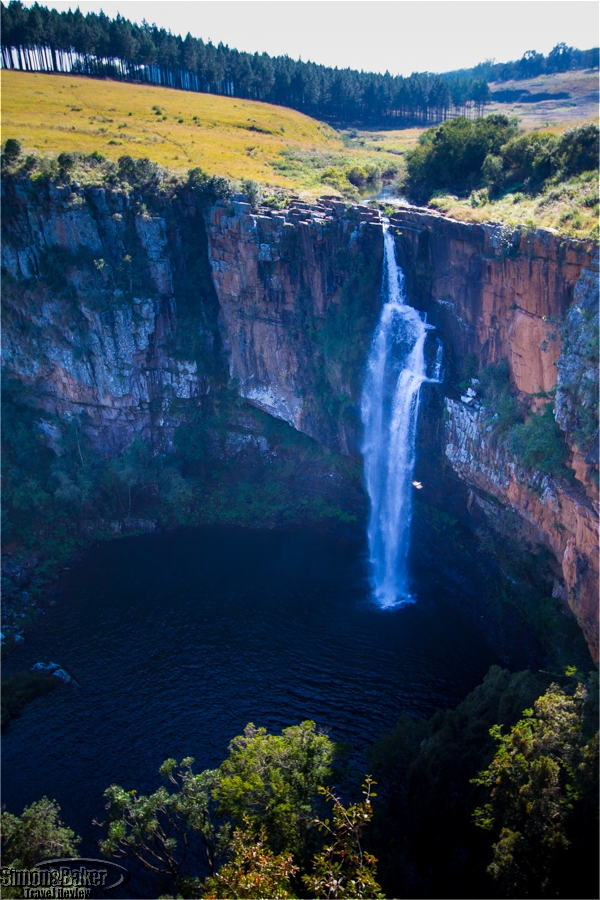
The Berlin Falls in Mpumalanga, South Africa
On a recent safari trip to South Africa earlier this year we had an opportunity to visit the Blyde River Canyon. One of the owners of the Belgrace Boutique Hotel, who also owned a tour company, invited us to a half day visit of the area as part of our transfer from his hotel to our safari property. Visiting the canyon required us to leave extra early. Our efforts were rewarded as the parking lot at the first of our stops was nearly deserted, except for curio vendors setting up for the day and staff cleaning the public bathrooms.
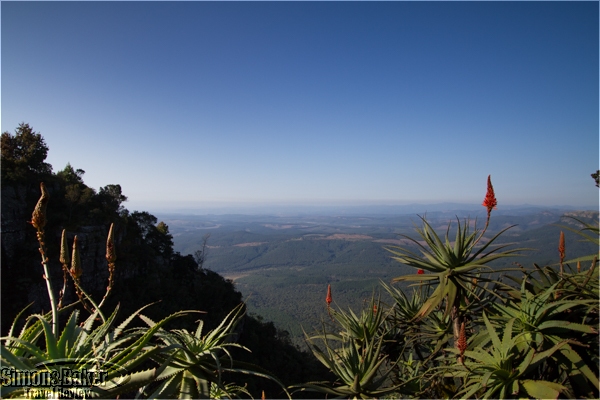
It was a little hazy, but the view from the God’s Windows lookout was breathtaking.
According to SouthAfrica.net, the 29,000 hectare Blyde River Canyon Nature Reserve is carved out of red sandstone and is one of South Africa’s most remarkable geological features. Salient areas of the “green canyon” we saw were the Three Rondavels or Three Sisters, God’s Window and Bourke’s Luck Potholes.
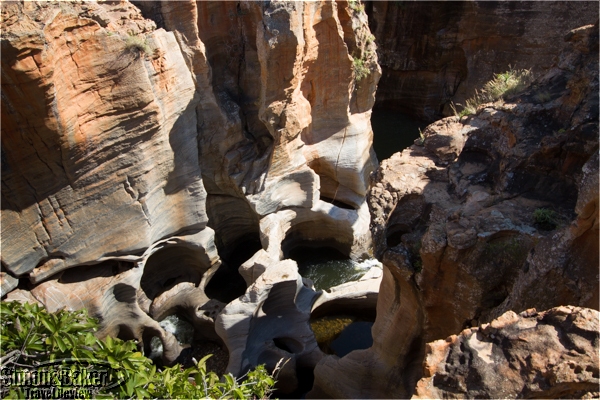
Over time the flow of water carved out circular “potholes” in the limestone of the valley.
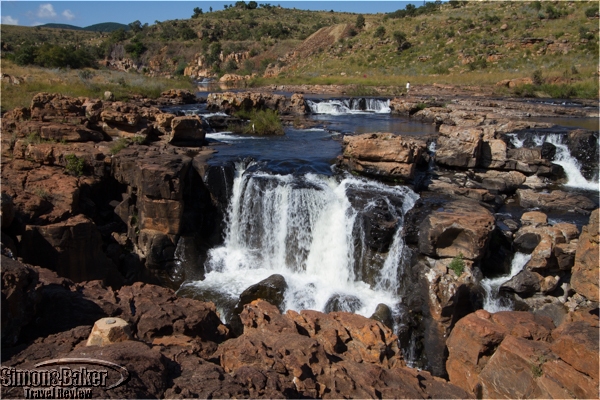
The river flows rapidly just above the potholes.
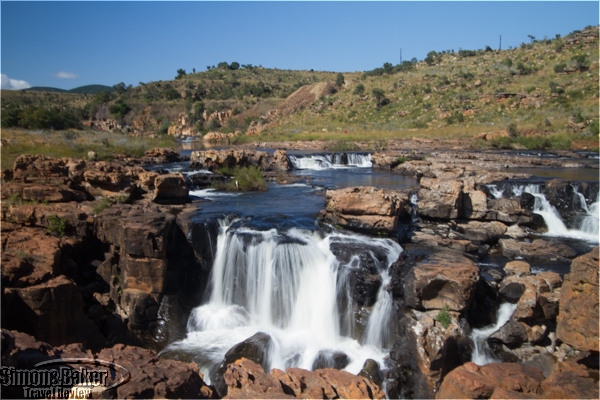
The same photo with a long exposure filter to smooth the water (just for fun)
The further along we progressed the more tourists we encountered, including several buses packed with travelers speaking foreign tongues. There were also more curio vendors in make shift structure and later inside a building. In lieu of lunch we snacked on locally produced cashews, macadamia nuts and dried fruits from a plastic container our tour escort brought with him. There were also chilled juices and water.

The Three Rondavels were our final stop as we made our way through the canyon.
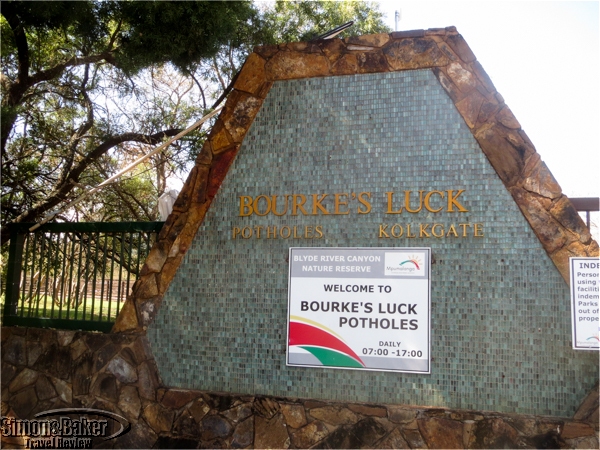
The series of attractions were part of the Blyde River Canyon Nature Reserve
The added attractions were worth the extra effort and time. Although we had few moments to spare for much beyond photos and quick rest stops we enjoyed the sights and the opportunity to see yet another beautiful natural wonder in the vast country full of natural treasures.
by Editor | Aug 28, 2017 | Attractions, Ecotourism
By Elena del Valle
Photos by Gary Cox
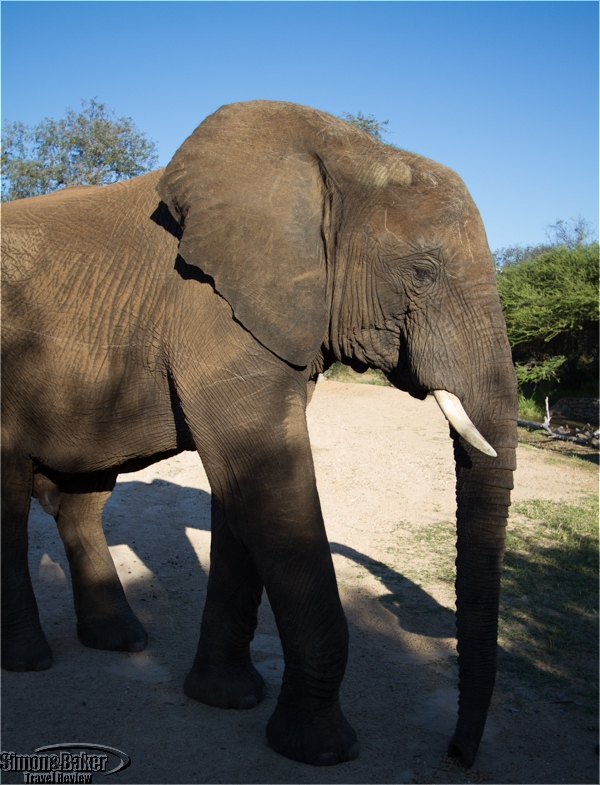
Jabulani, the camp’s namesake, at The First Meeting in May 2017
On our first visit to Camp Jabulani, a Five Star lodge near South Africa’s famed Kruger National Park, in 2008 we met some of the house elephants who had been raised or rescued by humans. After the young Jabulani, born in 1997, was abandoned by his elephant relatives when he became stuck in the mud the owners of the privately owned Big Five Kapama Reserve opened their hearts and their pockets to adopt him. In 2004, they established Camp Jabulani. When a herd of elephants in neighboring Zimbabwe was marked for slaughter they intervened, relocating the herd to their property.
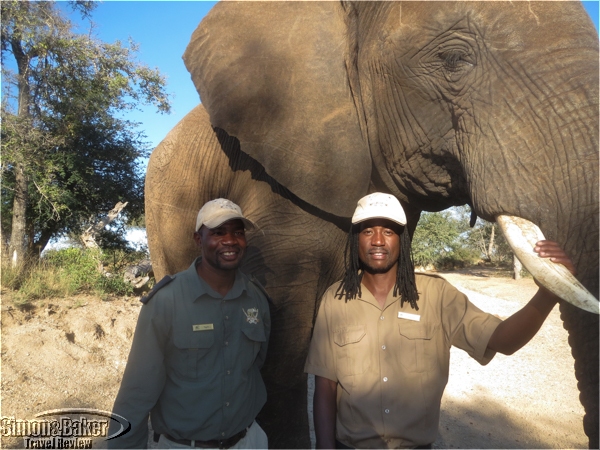
Left to right: Matipedza Tigere, elephant manager, and another staff member at The First Meeting, part of The Camp Jabulani Elephant Experience
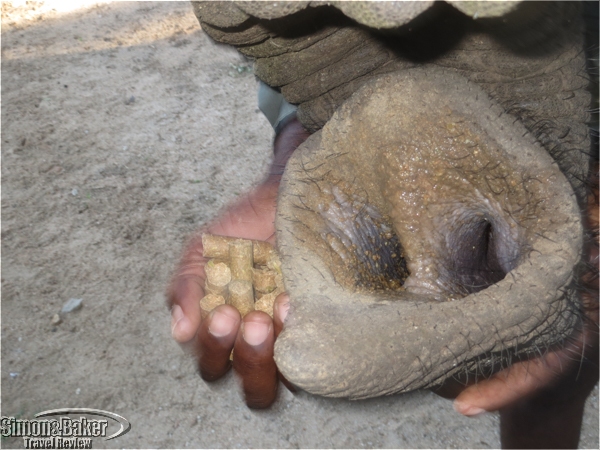
A staff member showed us how to feed the pachyderms pellets via the elephant’s trunk.
On that visit we met the whole herd, watched the staff tuck them in for the night and, most memorable of all, went elephant back riding. Earlier this year only weeks before our return, Camp Jabulani stopped offering elephant back rides. We wondered how the changes would affect our visit. We need not have worried as we had a comfortable stay and rewarding elephant experience at the luxury lodge.
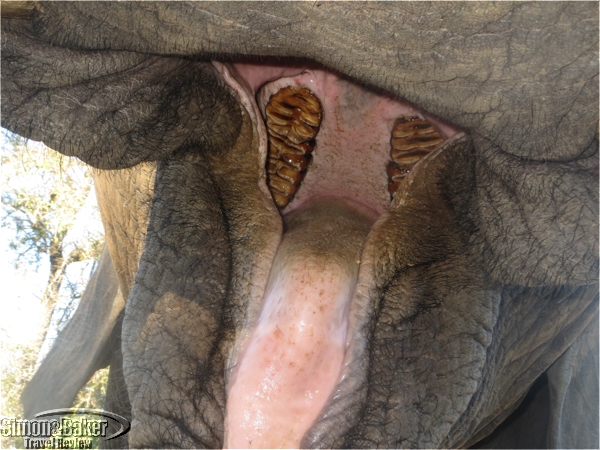
A closeup look at the elephant’s huge molars
“Camp Jabulani is a rather special lodge as it was established with the sole purpose of providing and income to look after Jabulani and a herd of elephants rescued from Zimbabwe in 2002,” Christo Rachmann, general manager, explained. “Currently the cost of looking after our elephants is around R450 000,00 per month. By visiting Camp Jabulani guests are actively contributing to the well-being of these magnificent animals.”
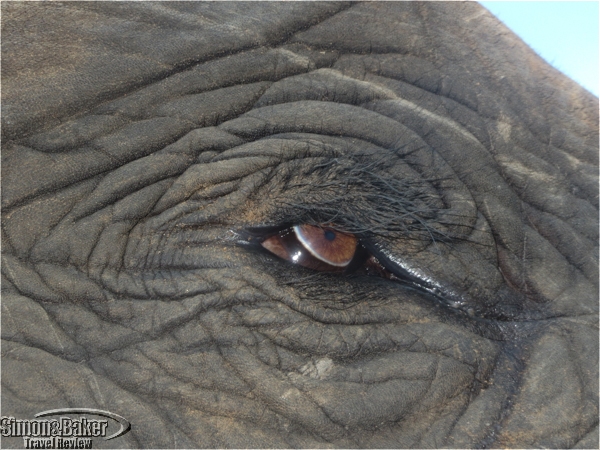
A closeup of the elephant’s huge eye and very long lashes was surprisingly difficult to photograph.
During our two night in stay in May 2017 we had The Camp Jabulani Elephant Experience. The day we arrived we had The First Meeting, part of The Camp Jabulani Elephant Experience. We spent a few minutes with Jabulani and another even larger young male. Under the watchful eye of Matipedza Tigere, elephant manager, we fed them pellet snacks, touched their skin and took photos. They smelled us with the tip of their trunk, quickly picked the pellets directly from our hands and let us run our hand along their side with surprising calm. Jabulani wrapped his trunk around my waist and dragged me gently yet firmly to one side (it was impossible to hold my position) until the elephant manager intervened.
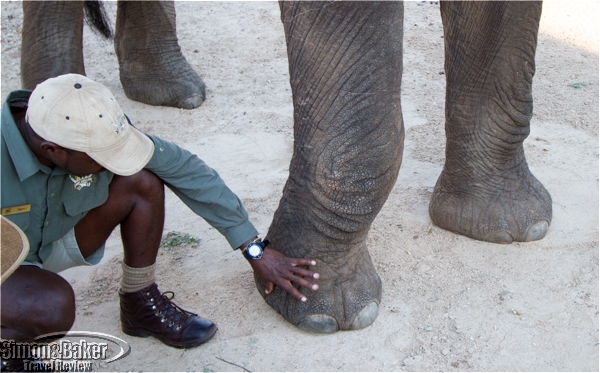
The elephant manager explained how an elephant’s foot carries its heavy body yet makes soft sounding footsteps.
Such nearness could give the false impression that elephants are easy to approach. Many safari trips have taught me that is far from true. I have a deep respect for the gentle giants. The elephants and the elephant manager’s relaxed demeanor reassured me as did his instructions. Tigere, a native of Chinhoyi, Zimbabwe, had 18 years of experience, and had a Field Guides Association of Southern Africa (FGASA) Level One Theory rating. He had been at Camp Jabulani since 2008. If he said it was safe to interact with the two huge creatures I believed him.
Because of the rescued elephants unique background the herd developed a positive atypical family structure. The staff explained that there are strong ties between male and female animals, and clearly established matriarchs have assumed responsibility for all infants, their own (five babies were born to the herd), as well as that of new orphans. The babies that have arrived in the last five years were successfully introduced to the herd with minimal human intervention. According to promotional materials, the managers and owners of Camp Jabulani planned to continue to rescue and rehabilitate elephants in need.
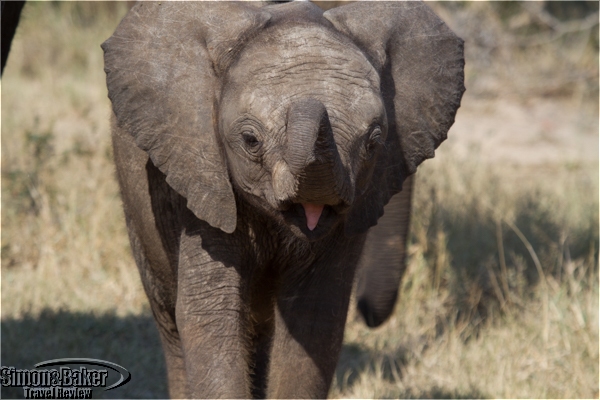
The youngest member of the herd was curious about our vehicle when we came to watch them play in the water
The following day at noon we waited for the 15 semi-tame elephants of the house herd to enter the water hole, hoping they would bathe. That was the In Their Element activity, also part of The Camp Jabulani Elephant Experience. We watched from our vehicle and they watched us back, curious. When playful elephants approached our vehicle our guide reversed, avoiding contact. A couple of times he revved the loud engine to make a particularly nosy elephant retreat. When we asked if there was danger he explained that wasn’t the case. They were curious about us and wanted to explore. The problem was that if an elephant brushed the new vehicle with its trunk it would damage the paint.
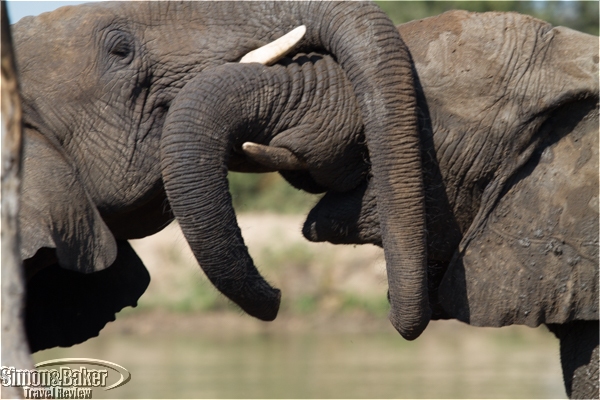
These younger members of the herd wrestled and played while we watched
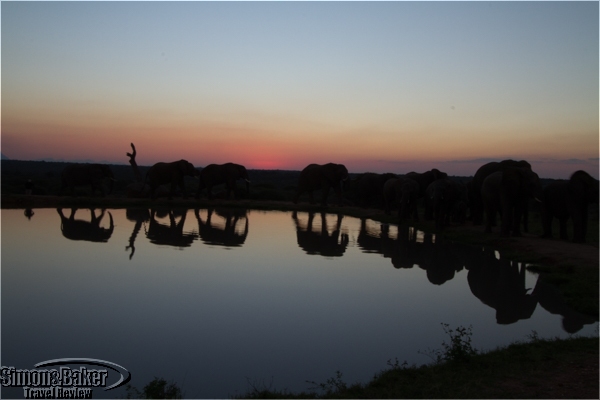
On the way to their pens for the night, the elephants paraded past our sun downer spot.
We watched the herd feed and interact. A number of elephant handlers sat around on the ground. We waved hello and they waived back. They called the youngest elephant to one side where they fed her a special extra nutritious blend from a bucket. For whatever reason the herd didn’t go in the water that afternoon. I didn’t mind much. Watching them so calm and playful was enough for me. A few minutes later the handlers rose to their feet, calling the herd away. As we drove back to Camp Jabulani I smiled. Our stay at the luxury property had been a pleasure, and seeing the elephants in close proximity the way we had was one of the main reasons.
by Editor | Aug 14, 2017 | Accomodations, Ecotourism, Luxury Travel
By Elena del Valle
Photos by Gary Cox
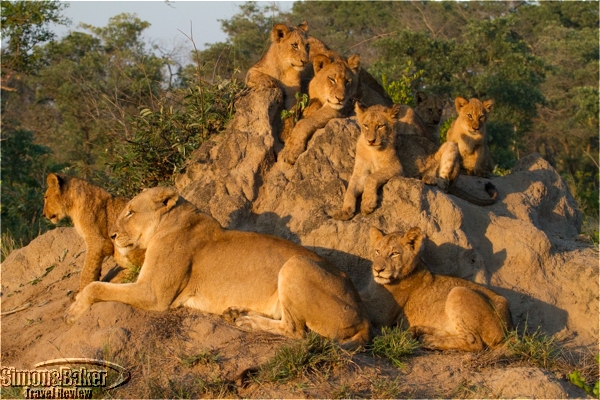
Watching the sun come up with the Southern Pride was one of the highlights of our trip.
On a recent safari trip to South Africa we stayed at Sabi Sabi Earth Lodge and Sabi Sabi Bush Lodge (Sabi Sabi Private Game Reserve, Sabi Sand Wildtuin, Mpumalanga, South Africa, lodge +27 13 7355-656, Sabi Sabi head office +27 11 447-7172, www.sabisabi.com, res@sabisabi.com). The two five star properties, members of the National Geographic Unique Lodges of the World, were family owned and located within the 6,000 hectare Sabi Sabi Private Game Reserve, which is within the Sabi Sand Reserve. It in turn is a Big Five reserve adjacent (without fences) to the famous Kruger National Park. At Bush Lodge we stayed in comfortable and spacious rooms, and we especially enjoyed the game viewing in a private vehicle and spa massage.

Our beds had color coordinated mosquito netting, a change from the customary white netting
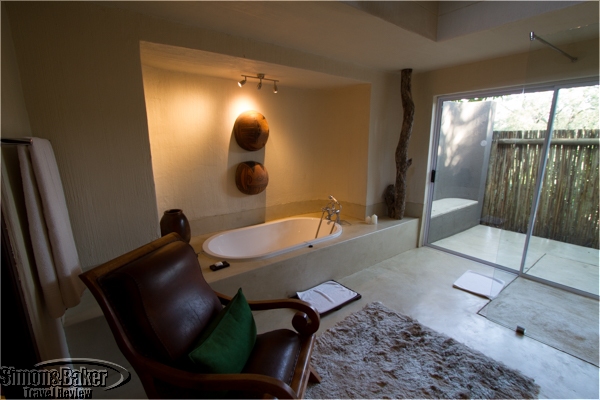
Our spacious bathrooms had a bathtub as well as indoor and outdoor showers.
During our visit, Stefan Schoeman, general manager lodges, Sabi Sabi, assisted us with camera related issues with speed and ease. We were glad to have our cameras in good working order since we saw the Big Five at Bush Lodge. On our first of two game drives we saw four of the Big Five. We drove around in an open Toyota LandCruiser in search of wildlife and interesting natural features to observe. We were delighted to have the game vehicle and Francois Rosslee, ranger, and Dollen Nkosi, tracker, to our selves. We have found that private game drives enhance our bush experience. So it was at Bush Lodge. Francois, a friendly man fond of his job, had been our ranger at Earth Lodge, where we had shared the vehicle with two other guests. That facilitated our arrival and check-in at its sister lodge.
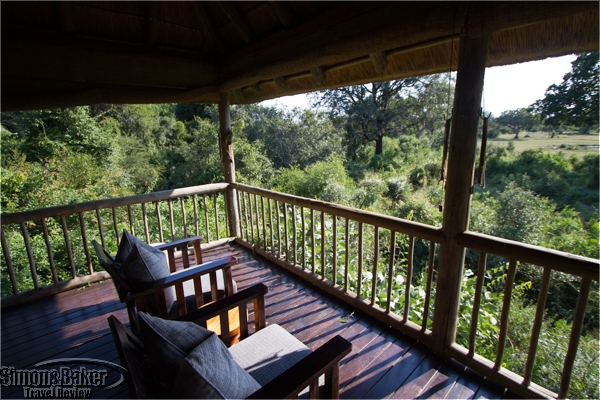
The main deck had several lookout points over the dry river
Francois was a Full Trails Guide Level 2 of the Field Guides Association of Southern Africa (FGASA) with six years of experience and a seemingly inexhaustible supply of energy. Dollen had attained a FGASA Tracker Level 2 and had been with Sabi Sabi for nine years.
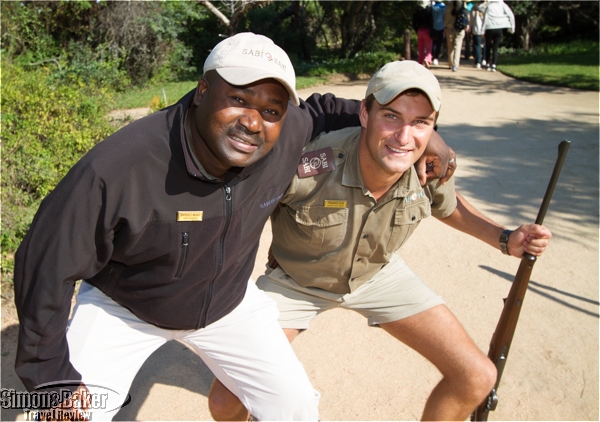
Our ranger Francois Rosslee (right) horsing around with Lawrence Mkansi, assistant lodge manager and head ranger
At Bush Lodge we saw the following mammals: buffalo, common duiker, dwarf mongoose, elephants, hippopotamus, kudu, leopard, lion, scrub hare, side-striped jackal, spotted hyena, tree squirrel, vervet monkey, warthog, waterbuck, white rhinoceros; insects: African monarch butterfly, Broad-bordered grass yellow, blue pansy, scarlet tip; trees and shrubs: jackalberry, knobthorn, leadwood, buffalo-thorn, silver cluster-leaf, large-leaved rock fig, greenthorn, and tamboti; and plants: wild cucumber, fannel weed, feather-top chloris, herringbone, and thatching yellow.
We saw or heard the following bird: African fish eagle, African grey hornbill, African scops-owl, bateleur eagle, Burchell’s starling, Cape glossy starling, Cape turtle dove, crested barbet, crested francolin, dark-capped bulbul, emerald-spotted wood-dove, fork-tailed drongo, go-away-bird, greater blue-eared glossy starling, green woodhoopoe, magpie shrike, rattling cisticola, redbilled oxpecker, southern yellow-billed hornbill, spotted thick-knee, Swainson’s spurfowl, laughing dove, Flappet lark.
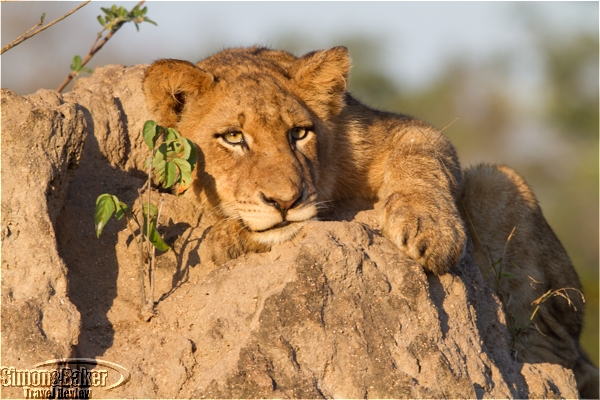
One of the lions
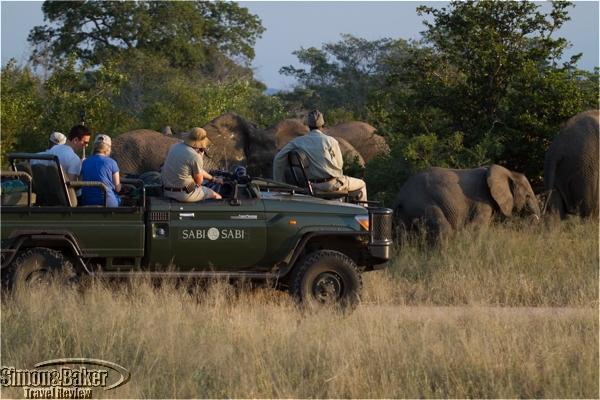
Approaching a sighting in progress
The 25 room family friendly property owned by Hilton and Jacqui Loon had two swimming pools, an amply stocked boutique shop (branded clothing, jewelry, coffee table books, art, accessories), Amani Health Spa, and EleFun Children’s Centre. Although the game reserve and lodge opened in 1979, during 2015 and 2016 the public areas and rooms were completely refurbished.

Our rooms had a sitting area, desk and small outdoor patio facing the dry riverbed.
Our 80 square meter well appointed Luxury Suites faced a dry riverbed. They were comfortably furnished (I especially appreciated the large pleasantly firm bed), quiet, cool when it was hot outside and warm when it was cold. Like its sister property it had a number of amenities such as coffee machine, mini refrigerator and perfume scented Charlotte Rhys toiletries as well as thoughtful touches like a convenient location for electric plugs on the desk and pre-stamped postcards.
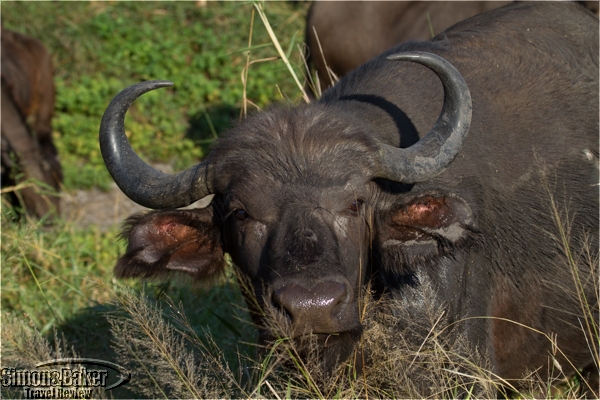
We had excellent closeup sightings of Cape buffalo, one of the Big Five.

A young kudu male with horns just developing

Stefan Schoeman, general manager, was a gracious host.
Meals were buffet style, with a made to order station, in an open air dining room in the main area. We sat at the table of our choice, where staff took our beverage orders. We enjoyed a delicious dinner, including Lamb neck, grilled meat and venison (gemsbock) in the boma (African open air enclosure).
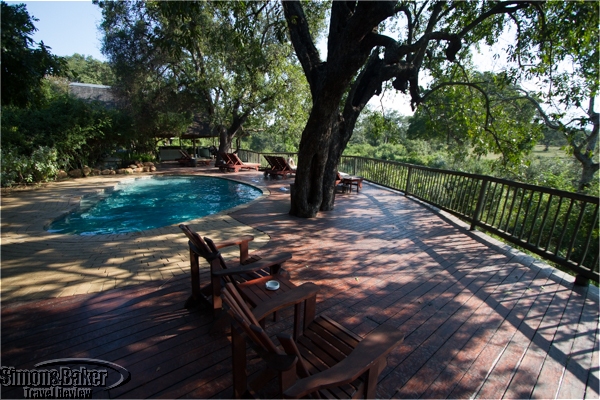
The pool deck had a view of the river
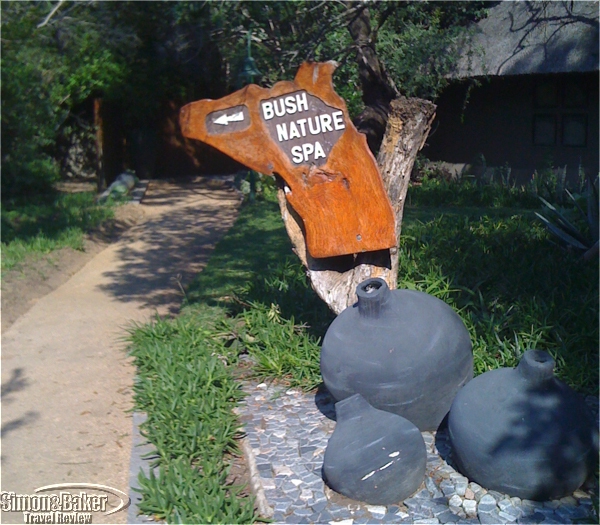
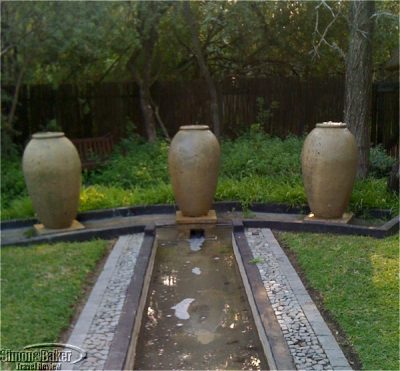
One of my favorite activities was a massage treatment with Tarren, the spa manager and Francois’s girlfriend. Had there been more time I would have explored the spa menu further. The excellent Big Five game viewing and spa treatment made our stay at Bush Lodge special. I would return and recommend it to friends seeking a family and group friendly stay in the Sabi Sand Reserve.
by Editor | Jul 31, 2017 | Ecotourism, Products
Article and Photos by Gary Cox
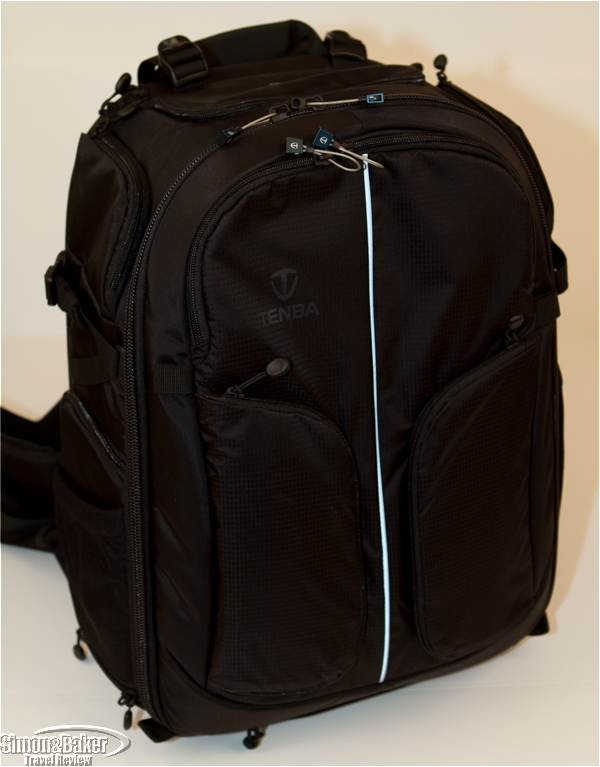
The Tenba Shootout Backpack 32L
Planning camera gear for an extended trip to Africa with location changes every two or three days starts with a solid transport solution. I don’t like anyone carrying my equipment, figuring that if someone is going to break stuff, it should be me. For my most recent trip, I chose the Tenba Shootout Backpack 32L (Tenba, 75 Virginia Road, North White Plains, New York 10603, +1 914 347 3300, www.tenba.com, info@tenba.com), and returned home happy with the decision and the performance of the bag. This is not a general purpose pack with some foam dividers stuffed into it, this is a backpack purpose built from the ground up for the photographer on the go.

My backpack has shoulder straps and a padded belt to distribute weight to the hips when worn.
The exterior of the backpack was made from water repellent twill and gray rip stop nylon. The interior compartments were built with rip stop nylon and soft tricot fabric, padded with perforated foam to minimize weight (six pounds empty). The center of the bag is for camera storage and featured water resistant pockets on the panel for storing memory cards and small items. It has full height pockets, one large on the front and one on the side for thin items. The other side has a half height pocket and an opening into the main chamber for quick access to a camera without unzipping the entire bag. There are some small organizing pockets on the front for miscellaneous items.
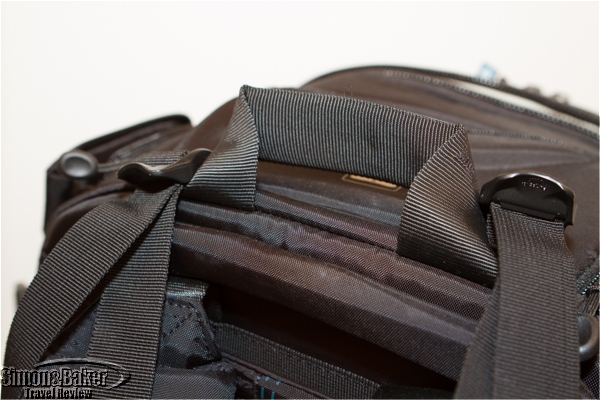
The padded handle allowed me to carry the load comfortably.
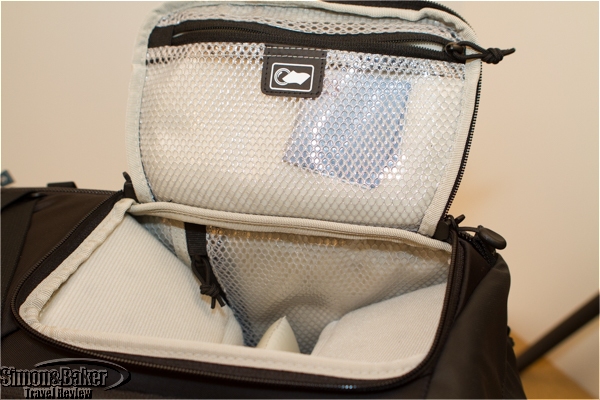
The side pocket gave me access to the main compartment and had a mesh pocket to store small items securely.
Near the handle on the top, there is a solid compartment to store fragile items. During the trip the compartment kept my sunglasses from being crushed. There is also a set of straps and a harness to attach a large tripod on the outside of the bag. A zippered compartment on the bottom holds a waterproof cover that can be pulled up over the bag like a little raincoat to keep it dry. Between the main compartment and the padded back brace and frame, there is a slot for a laptop or tablet. The zippers to the main compartment and front pocket can be locked with a small padlock, not included. The backpack, made in China, came with a small microfiber cloth and memory card wallet.
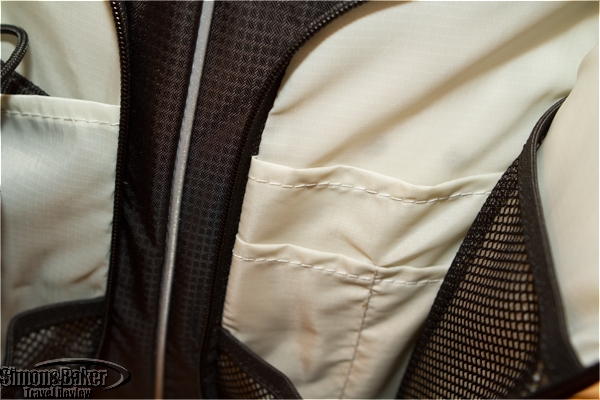
Opening the front pockets revealed more pockets for small items.
On safari trips to gather data on properties for the Simon and Baker Travel Review, I cannot afford to have any gear sidelined, so redundancy for key items is critical. On one trip, my wide angle lens bumped into the iron plating on the game viewing vehicle and broke. Apparently these are not in high demand for the average traveler in Botswana, and it was several days before I could get a replacement lens. I learned multiple lessons, pad everything during transfers and carry spares. The next challenge is the variety of shooting situations and the volume of photos I take. My go-to lens for general wildlife photography is the Canon 100 to 400 millimeter. It is versatile and a reasonable trade-off between weight and capability. On this trip, I included a 70 to 300 millimeter lens with the backup camera body.
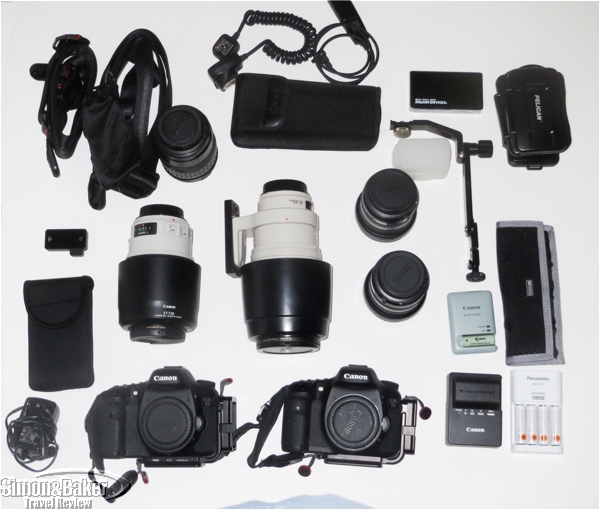
The camera equipment for our trip to Africa
I laid everything out before packing and started to wonder if the pack came in a larger size. Two camera bodies (Canon EOS 7D), two telephoto lenses, two wide angle lenses and a 28 to 130 millimeter for general purpose shooting. Flash, straps, batteries, chargers, memory cards, special purpose filters, macro adapter lens, cleaning supplies and iPad rounded out the final mix. It was a little tight, but everything fit and was well organized thanks to the bag’s dividers and pockets, including the handy well at the top for my sunglasses and mp3 player. With this load the backpack weighed over 30 pounds.
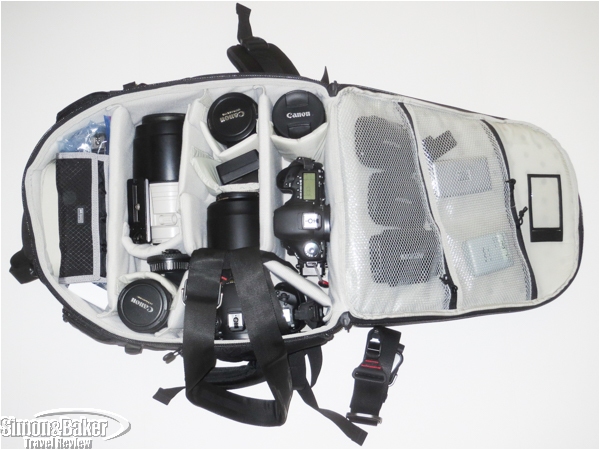
The main compartment held most of the camera gear
The fully loaded pack was comfortable to wear and distributed the weight across my shoulders and back. I am not a small guy and the straps had plenty of length, something I often find deficient in camera packs. The handle on the top of the bag was sturdy. The loaded pack rested upright and did not fall over when I set it on the ground. The padded belt could be a little annoying when I placed the bag into a cabinet or closet, but when I wore the backpack it was a godsend for balance and load distribution.
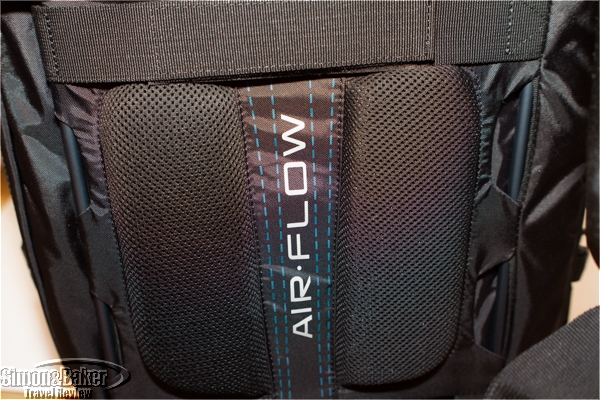
The Tenba Shootout Backpack 32L is padded and has a built in frame for stability.
The side of the bag has an easy access pocket to pull out a camera, but I never used that feature because my gear was too snug in the pack. I liked that the bag had lots of room for small things. It made it easy to keep organized. I used the pockets inside the main compartment for most of the memory cards and other valuable items. The outer pockets were handy for quick access, and ended up full of things I picked up when changing locations and then tidied away once we had rooms again. The tall side pocket was just right to hold my travel tripod. For the long haul flights I packed it away and only used the side pocket feature when changing properties in country. The zippers had nice easy to grab attachments and none of them became jammed or stuck.
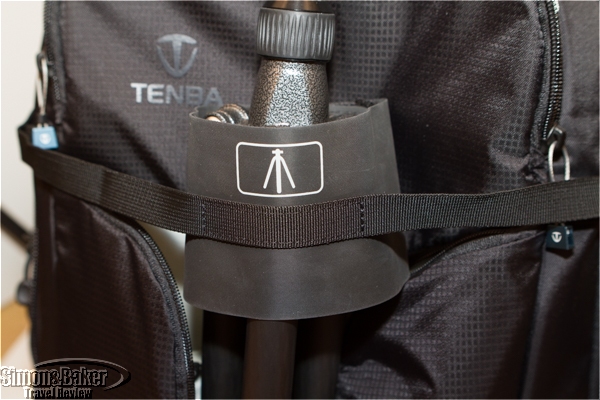
A strap allowed me to attach a tripod to the outside of the backpack.
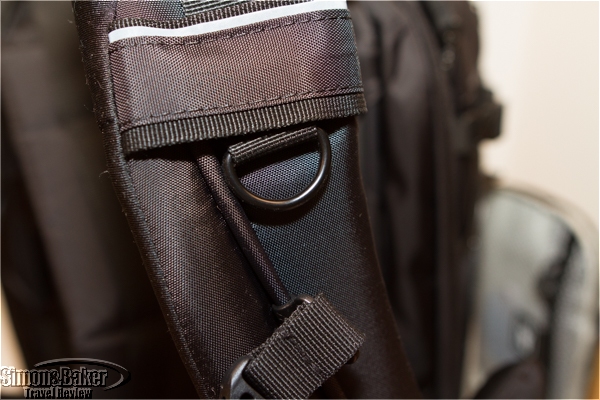
There were rings to attach external items on the shoulder straps
The bag held up well in extreme and varied conditions. For example, for the first 10 days we had intermittent rain and many opportunities to get muddy. The other three weeks were dry and dusty with a total of 12 property changes on planes, cars, vans and open safari vehicles. Everything inside my bag stayed safely clean and dry the entire time, and backpack arrived home looking new in spite of the opportunities to get muddy and dusty in the field. While pushing the luggage cart to the car in the parking lot at the airport at the end of the trip, the cart jammed solidly into a grating and the camera backpack flew off the top of the pile of bags landing on the parking lot surface. I assumed that a five foot forward flight and a four foot drop onto concrete would mean something was broken, but when I opened it at home, nothing was cracked or damaged. I would not recommend testing the backpack in that way, but it was good to know that when I let my guard down, the bag kept the contents unharmed. The Tenba Shootout Backpack 32L is my new choice for an expedition backpack to keep my gear safe.
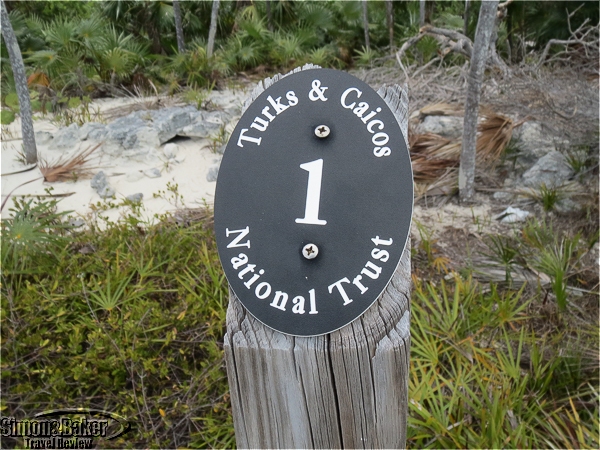
by Editor | Jun 6, 2016 | Attractions, Ecotourism
Article and photos by Elena del Valle
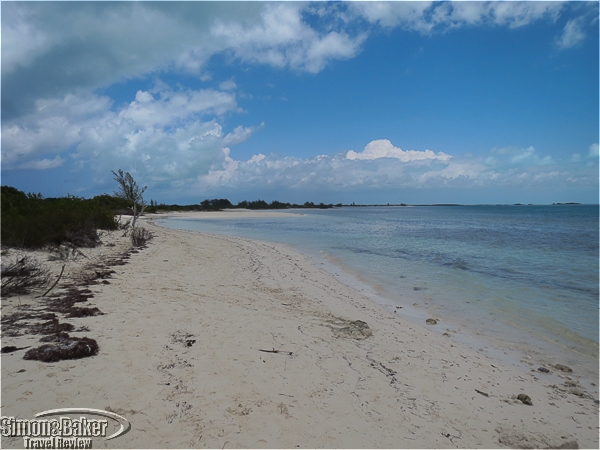
The beach at Little Water Cay also known as Iguana Island
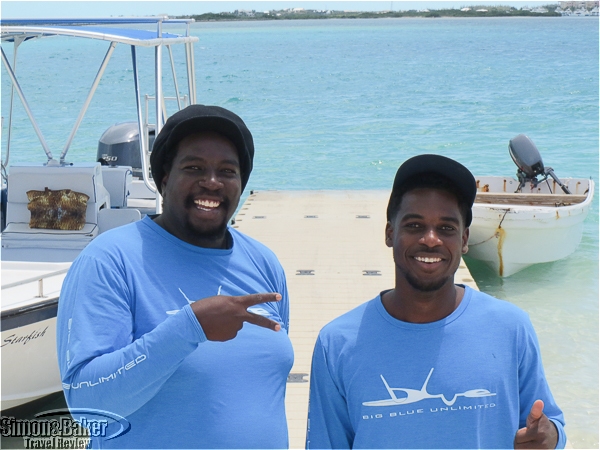
Mike and Cheno were our crew
The day after I arrived in Providenciales in the Turks and Caicos Islands of the British West Indies I received a call from Tanya at Big Blue Unlimited (Leeward Marina, Providenciales, Turks and Caicos Islands, +1 649 946 5034, fax +1 649 946 5033, info@bigblueunlimited.com), a company owned by Mark Parrish and Philip Shearer that specialized in small groups and eco-tours. I was scheduled for a morning snorkel activity the following day, but the weather was about to change and not in a good way. Tanya had kindly found a spot for me that afternoon if I could make it.
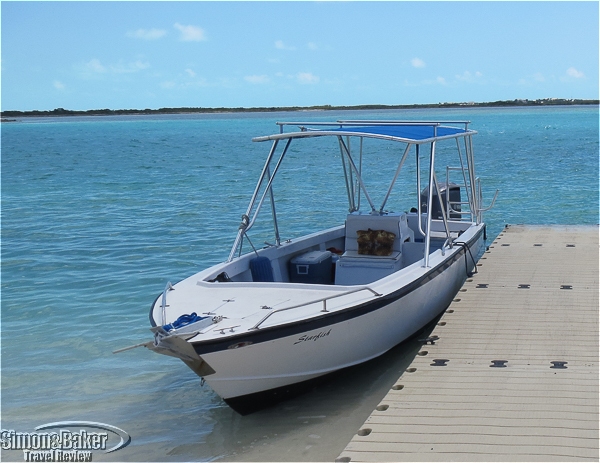
Our boat, Starfish
With a little help from Jessica at reception at my hotel, the Beach House Turks and Caicos in the Bight, I was able to reschedule my spa treatment. At 12:30 p.m. I climbed aboard the tour company’s navy blue van with a towel and biodegradable sunblock (as suggested in my booking confirmation) for the drive to the Big Blue Unlimited office at the Leeward Marina to join eight other travelers on a four hour Caicos Cays Cruise. On our way, we picked up six travelers from Club Med. A couple from another property in the Northwest Point met us at the tour company office.
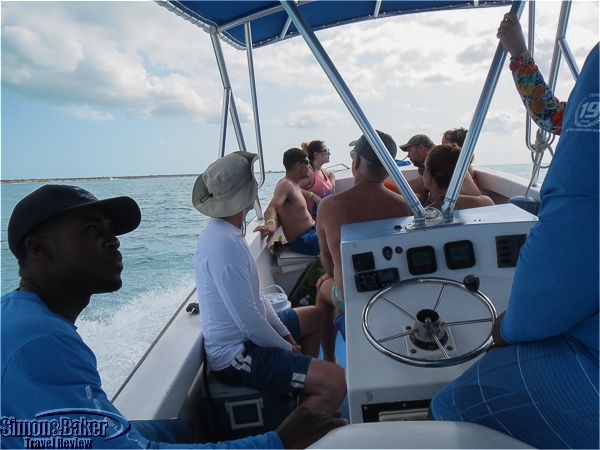
All the passengers and crew on the boat (except for me)
Within minutes of arriving we were ready. After signing a page long release form on an electronic tablet I joined my fellow travelers on the covered deck of the small office. Cheno and Mike, our crew members, introduced themselves and led us to the Starfish, our nine meter long boat for the afternoon. Mike, from North Caicos, had five years of water sports experience, three and a half with Big Blue Unlimited, and Cheno, a dive master from Atlanta and Grand Turks, had seven years of water sports experience, five of them with Big Blue Unlimited. They were friendly and managed the boat well.
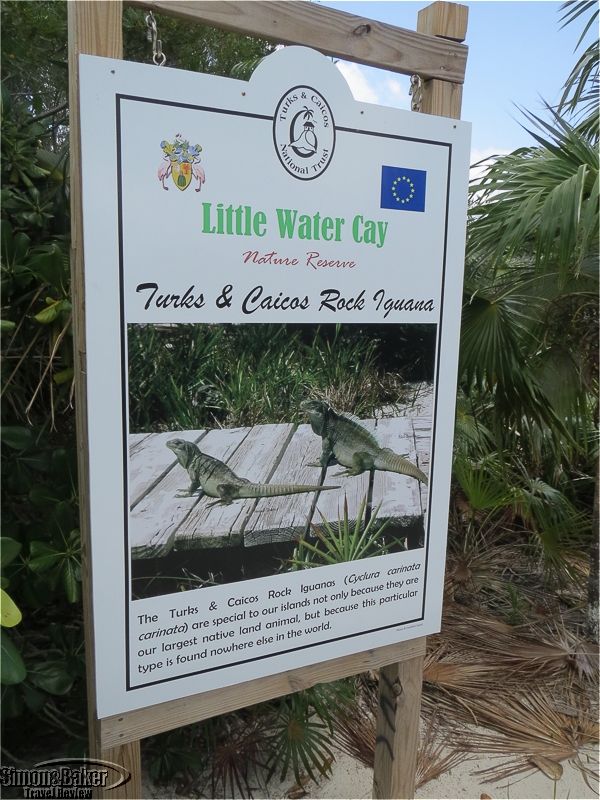
A sign for the Little Water Cay Nature Reserve
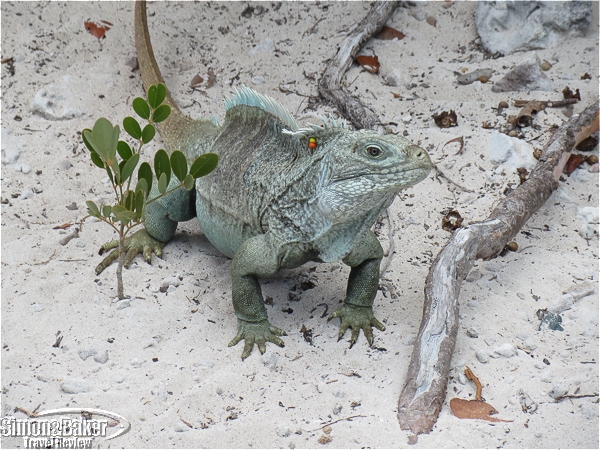
One of the male Turks and Caicos rock iguanas we saw
The Starfish had cushioned seating for three in the shady stern (back of the boat). It could accommodate the remainder of our group in the sunny bow (front of the boat). On our return to the marina everyone moved forward to avoid the water splashing the stern seat. Our first stop was at Little Water Cay, a small island managed by the Turks and Caicos National Trust, where we saw a number of Turks and Caicos rock iguanas close up. A local guide led the nine of use via a wood walkway, sharing insights about the iguanas and the island. From the small dock we looped around a short distance past palm trees, trust markers and signs, and the mostly unafraid reptiles back to our starting point, and to the boat in about 15 minutes.
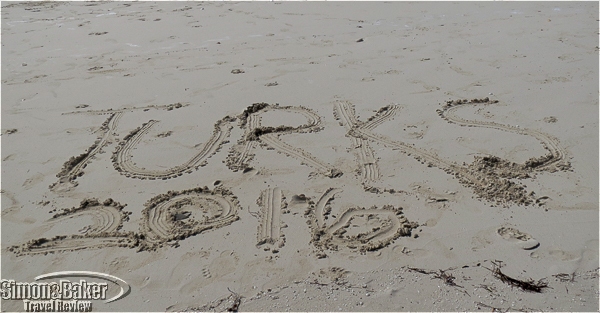
The sand was powdery white
I liked that the tour company sought to hire local islanders (a number of employees I met elsewhere on the island were foreign nationals), that its staff had received training about marine and coastal ecology, marine life identification, island geography and geology; and that Big Blue followed and promoted eco-tourism principals, as one of the owners explained by email.
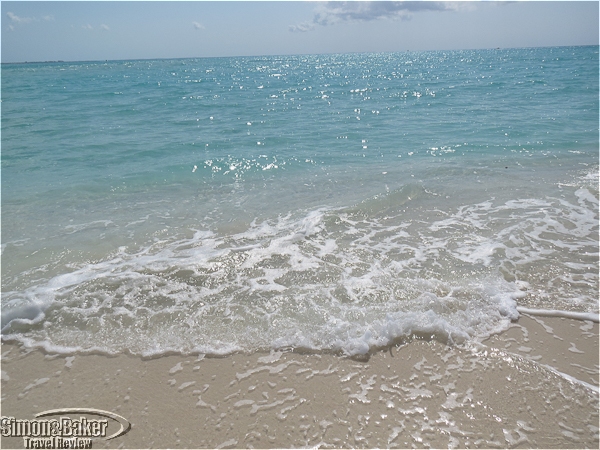
The shallow beach was like a swimming pool with white sand and clear water
From there we motored across turquoise waters to join other tour boats at Leeward Reef, where we remained about one hour. After we tied up to the reef buoy, Mike and Cheno helped us with snorkels and masks, put anti fogging liquid in the masks, and made sure we were comfortable once in the water. Cheno led three of us snorkeling, watching us every so often to make sure we were all right. He pointed out big fish such as an oversize parrot fish, a large grouper, a barracuda and three reef sharks at varying times. The swells were high and the water cool, but the snorkeling at Leeward Reef, about 12 feet deep, made up for the minor discomfort I felt. One of the other guests had to take over counter medication for seasickness when she returned to the boat.
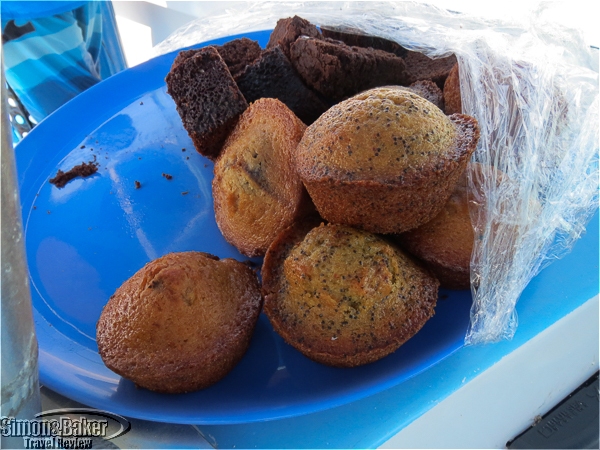
For snacks there were fruit slices, potato chips, muffins and brownies
After snorkeling, we went to Fort George Cay, where Mike and Cheno offered us rum punch or water and snacks of Lays potato chips, chocolate brownies, poppy seed muffins, and fresh fruit (cantaloupe and pineapple slices). Mike and Cheno stayed on the boat while the rest of us enjoyed some beach time. A short stroll from where we got off the boat the beach was shallow and the water crystal clear. It was also the warmest water I swam in during my stay in the Turks and Caicos Islands. We spent about an hour there before riding back to the marina. Moments later, we headed back to our respective hotels in the van. I made it back in time for a shower and an early dinner. For the rest of the evening I thought of the excellent visibility and fun snorkeling and beach. By the following morning the wind had picked up and the waves were choppy at the beach. I was thankful for Tanya’s call and to have enjoyed the snorkeling activity the previous afternoon.
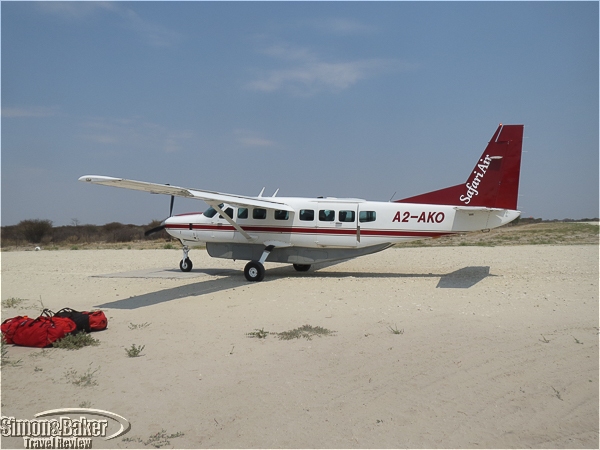
by Editor | Apr 25, 2016 | Accomodations, Attractions, Ecotourism, New Articles
By Elena del Valle
Photos by Gary Cox
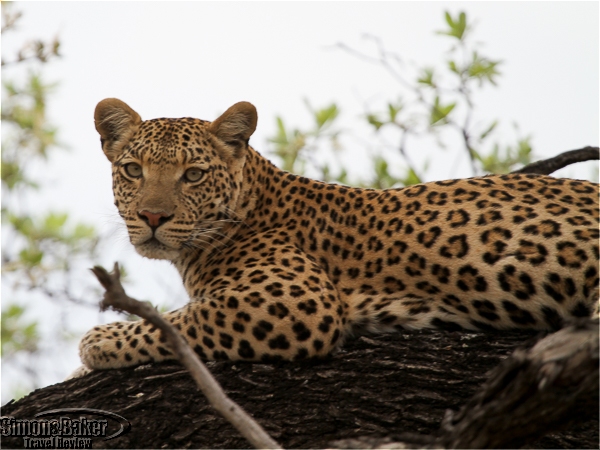
A leopard in a tree near Camp Moremi
On our most recent safari trip to Southern Africa we stayed at six Desert & Delta Safari properties, five in Botswana and one in the Caprivi Strip of Namibia. Traveling to properties within the same company offered advantages. The management similarities provided us an idea of what to expect before arriving at each subsequent property. For example, they all had eco-friendly policies; offered us moist refresher towels on arrival and when we returned from game drives as well as welcome back staff greetings when we returned from our activities; with only one exception, they all served buffet meals of similar styles at shared communal tables; the camps that depended on generators for electricity had battery operated lights for times when the generators were off at night; and most were run by a four-person management team, many of whom were friendly and helpful when asked.
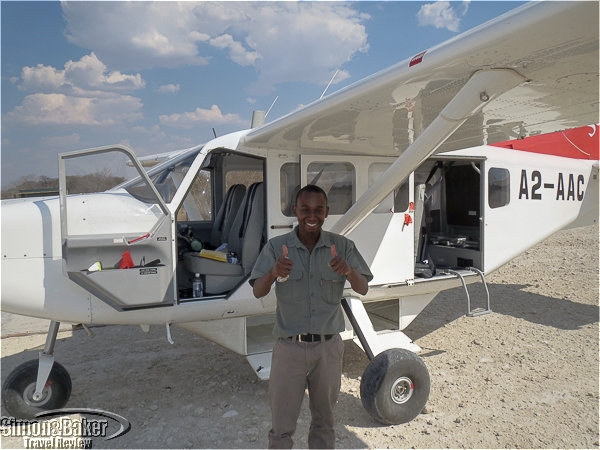
Our pilot bids us farewell after our arrival at Leroo La Tau from Maun to start the adventure

Safari Air had several comfortable Caravan aircraft
Another advantage of traveling to Desert & Delta Safaris properties was their shared charter air service. Since Chobe Holdings Limited owned Desert & Delta Safaris and Safari Air (Desert & Delta Safaris, Private bag 310, Maun, Botswana, +267 6861243, http://www.desertdelta.com, info@desertdelta.com), a non scheduled charter safari airline founded in 1992 and based out of Maun, they coordinated our transfers between the Desert & Delta Safaris properties and between our international arrival and departure airports. The company owned five GA8 Airvan, three Cessna Caravan and one Quest Kodiak. We appreciated the convenience of the well organized and on time service.
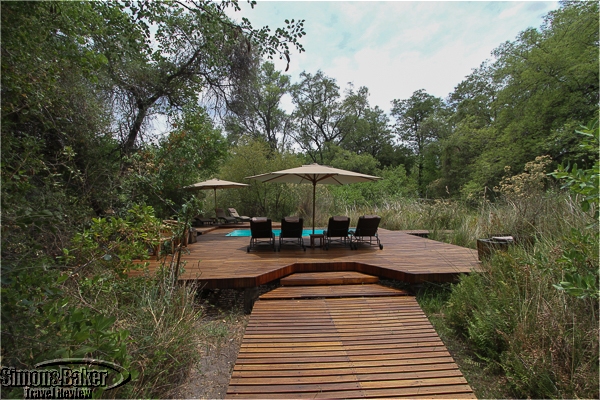
The heat drove many poolside in the afternoons
Our stay was hampered in part by a regional heat wave that stretched all the way to South Africa. Four of the six properties ran on generators. Because the rooms remained sealed most of the day they became over hot around the clock. More than once we or our fellow travelers became ill from the heat and dehydration. Thankfully, the game viewing vehicles had partial shade. In addition, wet face cloths and pool dips were helpful in reducing our body temperature.
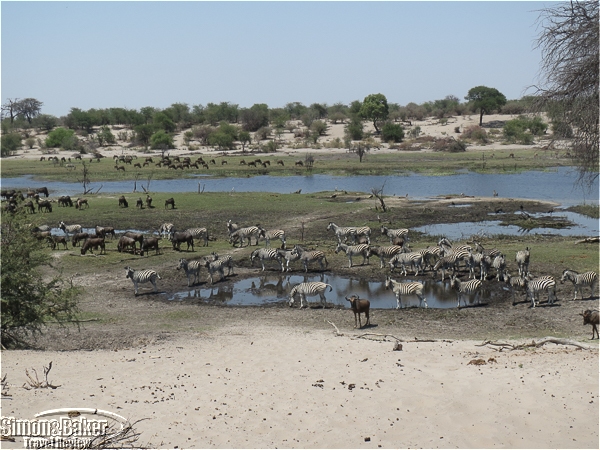
The wildlife was centered around the Boteti River banks near Leroo LaTau
Leroo LaTau, on the edge of the Makgadikgadi National Park, was our favorite for game viewing and views of the Boteti River from our rooms and the common areas. This was in part because Slade, our guide, was one of the most passionate and engaged of the guides we spent time with on that three country multi week itinerary. We enjoyed seeing a bit of the regional zebra migration and predators such as lions and wild dogs as well as brilliant sunsets over the shallow waters of the river.
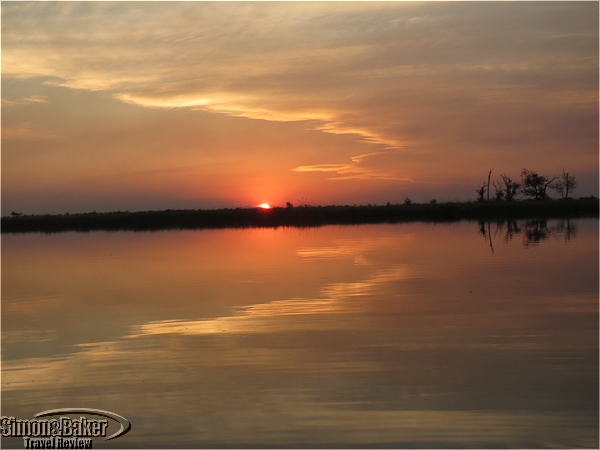
Sunset over the Okavango Delta
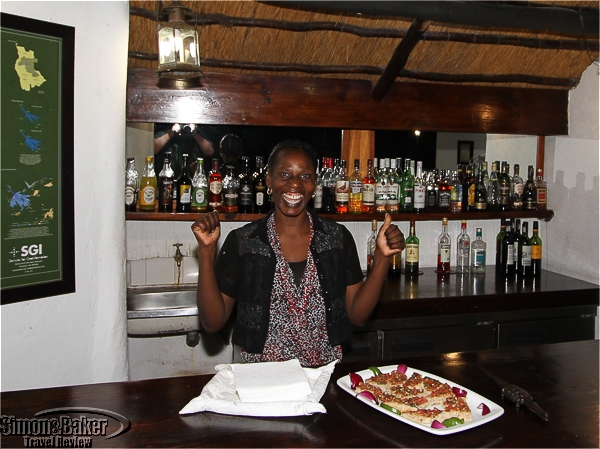
Time for a drink before dinner at Xugana Island Lodge
In Camp Moremi (see Tented camp offered good game viewing, creature comforts on edge of Okavango Delta) we liked the expansive views from the elevated deck. At Xugana Island Lodge, we delighted in the birding within the island, the sense of remoteness within the famous Okavango Delta, and pretty water setting as well as many boat outings and occasional hippo sightings. Savute Safari Lodge had the prettiest rooms and some of the tastiest and most abundant meals. We especially liked the views of the man made waterholes from the dining area and our tented rooms.

Breakfast at the Chobe Game Lodge with a view of the Chobe River
At the Chobe Savanna Lodge and Chobe Game Lodge, situated on opposite sides of the Chobe River and in separate countries, we were thankful for the air conditioned rooms. Although the border crossing from Botswana to Chobe Savanna Lodge on the Namibia side of the Chobe River was time consuming, hot and tedious we enjoyed the shady leisurely river rides on the pontoon boat. We particularly liked it when our boat was one of few on the river and we were alone with our local guide. The flat river water and quiet when the motor was off were particularly appealing. At the Chobe Game Lodge, we appreciated the three daily game viewing activities, and luxury amenities such as plated meals at private tables, in-room phones, WiFi internet access, work out room, spa room and its innovative electric safari vehicle.
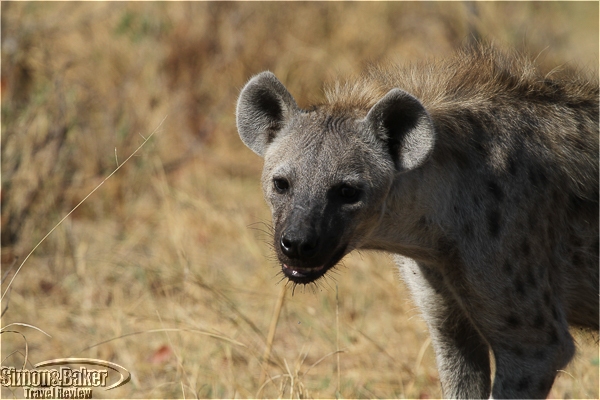
A hyena in the Chobe Game Reserve
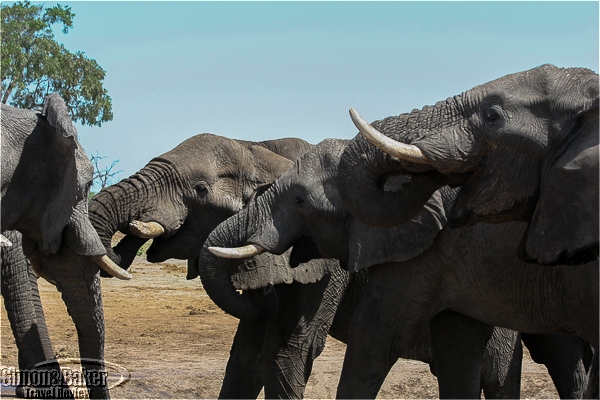
Elephants sharing a waterhole near Savute Safari Lodge in Chobe
Overall we had a fun trip and numerous bird and wildlife sightings of common species such as zebra, wildebeest, giraffe, impala, red lechwe (at Xugana), including elephant, buffalo, leopard and lion from the coveted Big Five. We saw beautiful birds, including the elusive paradise flycatchers, fish eagles multiple times, and particularly remember pairs of fish eagles relatively close to our boat at the Chobe Savanna Lodge. During the trip, we had extraordinary sightings such as wild dogs at Leroo La tau, crocodiles hunting, interactions between lions and elephants and numerous striking landscape and waterscape moments that will linger in our memories for years to come, and draw us back to Botswana and Africa in the future.




































































